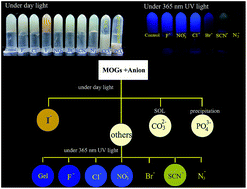Luminescent Zn(ii)–terpyridine metal–organic gel for visual recognition of anions†
Abstract
Luminescent metal–organic gels (MOGs), prepared with zinc sulfate and 4-[2,2′:6′,2′′-terpyridine]-4′-ylbenzoic acid (Hcptpy), have a good visual recognition ability for anions, which is visible with the naked eye, due to the affinity of anions to the zinc ion center in the MOGs.


 Please wait while we load your content...
Please wait while we load your content...